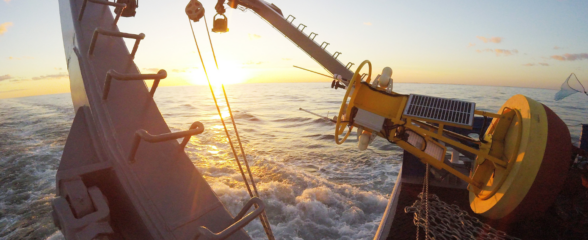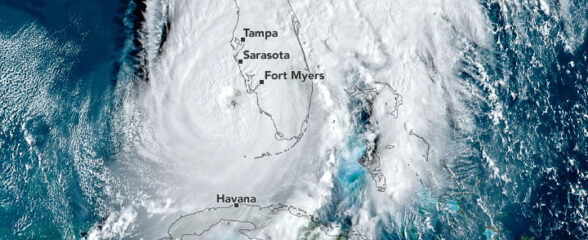After years of study, University of South Florida College of Marine Science researchers and colleagues have identified reasons why some years are worse than others for the harmful alga bloom (HAB) Karenia brevis, called "red tide," when it occurs off the west coast of Florida.
In a recently completed study comparing data collected on the 2012 red tide season, which was particularly robust, compared to the 2013 season, which was not, the scientists found that the coastal ocean circulation on the West Florida Continental Shelf – highly dependent on the Gulf of Mexico Loop Current – was a determining factor in the greatly differing red tide occurrences. Their paper describing this research was recently published in the journal Continental Shelf Research.
K. brevis creates a toxin that is threatening to organism health. In years of the worst outbreaks, red tide is responsible for millions of dollars in losses in the shellfish, finfish, recreation and tourism industries. Red tide toxins that end up in the food web can be transferred to other forms of life, from tiny zooplankton to birds, fish, aquatic mammals and humans. Toxins may also be inhaled, causing respiratory distress. While red tide occurs naturally in the Gulf of Mexico, knowing when and where a red tide threat may emerge and how it may evolve along the coast is important. A number of predictive tools are in development to investigate this natural phenomenon, which has both biological and physical dimensions.
"Coastal ocean ecology is not just biology," said study lead-author Robert Weisberg, Distinguished University Professor of Physical Oceanography at USF's College of Marine Science and also a SECOORA Principal Investigator. "It integrates all processes responsible for organism success and requires a systems science approach to understand it, complete with observations and coordinated models. The observations must include a variety of sensors and deployment systems because no single observation method is adequate to describe red tide's underlying three-dimensional processes."
Weisberg, along with study co-authors John Walsh, Distinguished University Professor of Biological Oceanography, and their research associates and colleagues at USF and at neighboring Florida Water Research Institute, have developed tools for observing, tracking and forecasting red tides using a combination of moored instrumentation, robotic gliders, satellite imagery and computer models. While biology and chemistry control the growth of the blooms, it is ocean circulation that unites the nutrients with sunlight to facilitate photosynthesis, said Weisberg. Ocean circulation also transports offshore blooms to the coast. If the circulation conditions are not right, then a red tide will neither bloom, nor manifest along the coastline.
In this study, the simplifying factor was identified to be the Gulf of Mexico Loop Current. When the Loop Current interacts with the shelf slope near the Dry Tortugas it can set the entire shelf in motion, bringing new nutrients onto the shelf from the deeper ocean. This sequence of events suppresses red tide by favoring other, faster growing phytoplankton (microscopic sea plants). By and large, the position of the Loop Current in spring and early summer provides a predictor of fall red tide conditions.
How did conditions vary from the bad red tide in 2012 to the nearly non-event of 2013?
"As revealed by monthly snapshots of sea surface height from satellite imagery and other estimates, the Loop Current from late winter through summer 2012 was positioned to the west of the shelf slope in deeper water," Weisberg explained. "In contrast to this, the Loop Current was in close proximity to the shelf slope near the Dry Tortugas prior to the 2013 fall season. As a result, 2012 saw a major red tide, whereas 2013 did not."
As documented by the Florida Fish and Wildlife Conservation Commission, the 2012 bloom resulted in the mortality of 293 endangered Florida manatees, the greatest number of red tide-related manatee deaths recorded from a single bloom.
"This study confirmed that ocean circulation physics and K. brevis biology are equally important and that both immediate and short term prediction may be achieved using a combination of circulation models supported by in situ observations of physical, biological and chemical variables and satellite imagery," concluded the researchers.
For more information, please visit http://ocg6.marine.usf.edu/
Related news

Funding Cuts to NOAA IOOS Will Hurt the Southeast
Proposed federal funding cuts would eliminate the IOOS Regional Observations budget for next year. Contrary to the budget Congress has already approved for this year, the Executive Branch wants these proposed cuts to go into effect in 2025.

SECOORA Webinar on the Rapid Intensification of Hurricane Ian: Warm Subsurface Water on the Wide Continental Shelf
Join us Thursday, April 24th at 12 PM ET for the April installment of the SECOORA Coastal Observing in Your Community Webinar Series! This month, we will hear from Dr. Yonggang Liu from the University of South Florida. He will discuss his research on the rapid intensification of Hurricane Ian in relation to anomalously warm subsurface water on the wide...

Webinar: SECOORA Data Portal Demo
Join us on Thursday, February 20, 2025 at 1:00 PM ET to learn more about the SECOORA Data Portal and how to navigate it. Axiom Data Science will be providing an overview of the portal, including how to search the Catalog and make a custom data view.